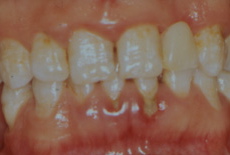| |
The role of bacteria in the initiation of inflammatory response in the supporting tissue around the teeth has been documented in the literature.
More recently scientific papers have emphasized the association of periodontal disease with systemic diseases such as cardiovascular disease, diabetes, pre-term low-weight birth infants and even nosocomitant hospital based infections.
When the bacterial plaque is not removed with regular home care it accumulates around the teeth and triggers disease activity, more commonly known as GINGIVITIS. Depending on the severity of the inflammation, patients could experience redness, swelling, bleeding gums, bad taste, and bad odor, sometimes even abscess and infection could be present in their mouth.
When the inflammation is contained to the gingival unit, a good full mouth debridement (scaling) followed by a more stringent hygiene habits, and regular maintenance visit is the required treatment.
Once the bacterial plaque invades the structures below the gingiva, known as the periodontium (supporting tissue of the tooth), the disease entity is called PERIODONTITIS.
In a susceptible individual the periodontal pathogens (bacteria) will cause loss of attachment (recession and bone loss) and if left untreated ultimately will lead to tooth loss.
The treatment could be I: Non-surgical such as full-mouth scaling and root planning (deep scaling) with local anesthesia and sometimes utilizing systemic antibiotics as an adjunct.
| |

Initial |
|

Six weeks later |
|
|
|
